Physiology and pathophysiology of SLC12A1/2 transporters
- PMID: 24097229
- PMCID: PMC3877717
- DOI: 10.1007/s00424-013-1370-5
Physiology and pathophysiology of SLC12A1/2 transporters
Abstract
The electroneutral Na(+)-K(+)-Cl(-) cotransporters NKCC1 (encoded by the SLC12A2 gene) and NKCC2 (SLC12A1 gene) belong to the Na(+)-dependent subgroup of solute carrier 12 (SLC12) family of transporters. They mediate the electroneutral movement of Na(+) and K(+), tightly coupled to the movement of Cl(-) across cell membranes. As they use the energy of the ion gradients generated by the Na(+)/K(+)-ATPase to transport Na(+), K(+), and Cl(-) from the outside to the inside of a cell, they are considered secondary active transport mechanisms. NKCC-mediated transport occurs in a 1Na(+), 1K(+), and 2Cl(-) ratio, although NKCC1 has been shown to sometimes mediate partial reactions. Both transporters are blocked by bumetanide and furosemide, drugs which are commonly used in clinical medicine. NKCC2 is the molecular target of loop diuretics as it is expressed on the apical membrane of thick ascending limb of Henle epithelial cells, where it mediates NaCl reabsorption. NKCC1, in contrast, is found on the basolateral membrane of Cl(-) secretory epithelial cells, as well as in a variety of non-epithelial cells, where it mediates cell volume regulation and participates in Cl(-) homeostasis. Following their molecular identification two decades ago, much has been learned about their biophysical properties, their mode of operation, their regulation by kinases and phosphatases, and their physiological relevance. However, despite this tremendous amount of new information, there are still so many gaps in our knowledge. This review summarizes information that constitutes consensus in the field, but it also discusses current points of controversy and highlights many unanswered questions.
Figures
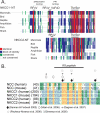
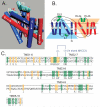
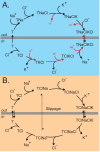

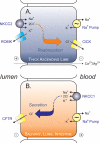
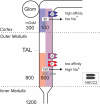
Similar articles
-
Increased Slc12a1 expression in β-cells and improved glucose disposal in Slc12a2 heterozygous mice.J Endocrinol. 2015 Dec;227(3):153-65. doi: 10.1530/JOE-15-0327. Epub 2015 Sep 23. J Endocrinol. 2015. PMID: 26400961 Free PMC article.
-
The Na-K-Cl cotransporters.J Bioenerg Biomembr. 1998 Apr;30(2):161-72. doi: 10.1023/a:1020521308985. J Bioenerg Biomembr. 1998. PMID: 9672238 Review.
-
Plasma Membrane Targeting of Endogenous NKCC2 in COS7 Cells Bypasses Functional Golgi Cisternae and Complex N-Glycosylation.Front Cell Dev Biol. 2017 Jan 4;4:150. doi: 10.3389/fcell.2016.00150. eCollection 2016. Front Cell Dev Biol. 2017. PMID: 28101499 Free PMC article.
-
The Na-K-Cl cotransporter of secretory epithelia.Annu Rev Physiol. 2000;62:515-34. doi: 10.1146/annurev.physiol.62.1.515. Annu Rev Physiol. 2000. PMID: 10845101 Review.
-
Structural basis for human NKCC1 inhibition by loop diuretic drugs.EMBO J. 2025 Mar;44(5):1540-1562. doi: 10.1038/s44318-025-00368-6. Epub 2025 Jan 28. EMBO J. 2025. PMID: 39875725 Free PMC article.
Cited by
-
Current perspective on circadian function of the kidney.Am J Physiol Renal Physiol. 2024 Mar 1;326(3):F438-F459. doi: 10.1152/ajprenal.00247.2023. Epub 2023 Dec 22. Am J Physiol Renal Physiol. 2024. PMID: 38134232 Free PMC article. Review.
-
Clinical and Genetic Characterization of Patients with Bartter and Gitelman Syndrome.Int J Mol Sci. 2022 May 18;23(10):5641. doi: 10.3390/ijms23105641. Int J Mol Sci. 2022. PMID: 35628451 Free PMC article.
-
A dileucine motif in the COOH-terminal domain of NKCC1 targets the cotransporter to the plasma membrane.Am J Physiol Cell Physiol. 2019 Apr 1;316(4):C545-C558. doi: 10.1152/ajpcell.00023.2019. Epub 2019 Mar 13. Am J Physiol Cell Physiol. 2019. PMID: 30865516 Free PMC article.
-
Off-Label Use of Bumetanide for Brain Disorders: An Overview.Front Neurosci. 2019 Apr 24;13:310. doi: 10.3389/fnins.2019.00310. eCollection 2019. Front Neurosci. 2019. PMID: 31068771 Free PMC article. Review.
-
NKCC1 and NKCC2: The pathogenetic role of cation-chloride cotransporters in hypertension.Genes Dis. 2015 Jun;2(2):186-196. doi: 10.1016/j.gendis.2015.02.007. Genes Dis. 2015. PMID: 26114157 Free PMC article.
References
-
- Altamirano AA, Breitwieser GE, Russel JM. Vanadate and fluoride effects on Na-K-Cl cotransport in squid giant axon. Am J Physiol. 1988;254:C582–C586. - PubMed
Publication types
MeSH terms
Substances
Grants and funding
LinkOut - more resources
Full Text Sources
Other Literature Sources
Medical
Molecular Biology Databases
Research Materials

